History of early Tunisia facts for kids
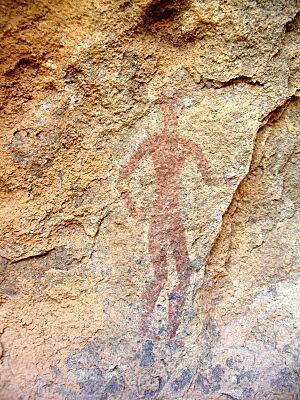
Humans have lived in North Africa for over a million years! Scientists have found traces of early humans, like Homo erectus, from about 750,000 years ago. These early people used simple stone tools.
The Berbers are an ancient group of people who have lived in North Africa for thousands of years. They were here long before the Phoenicians arrived and founded the city of Carthage. The Berber people came from a mix of different ancient groups, like the Capsian culture. Over time, these groups blended together to form the unique Berber identity. After this, the Berbers lived as independent people across North Africa, including the area we now call Tunisia.
It's hard to know everything about these very old times because there aren't many written records. But studying Berber languages helps us understand their long history. It shows how Tunisian Berbers are connected to other Berber groups and even to other distant peoples from long ago.
The time before written history slowly changed into the first historical periods. The first time Phoenicians and Berbers met was far to the east of Tunisia, long before Carthage was built. In fact, a pharaoh from a Berbero-Libyan family (the 22nd dynasty) even led an invasion of Phoenicia around 900 BC!
In the Maghreb region (Northwest Africa), the first written records about the Berbers talk about the Tunisian area. This was around the time Carthage was founded. Sadly, most ancient writings from Carthage are lost. There are also only a few writings left from the ancient Berber script. Most of what we know comes from later Greek and Roman writers. By looking at old tools, buildings, and these writings, we can learn a bit about early Berber culture, society, and beliefs.
Tunisia was a very important region for the Berber people during the time of Carthage, and later during Roman and early Islamic times. We can learn about their ancient lives, homes, and how their communities were organized, including large groups of tribes. We get clues from old objects, settlements, burial sites, writings, and even from studying genetics and languages.
Contents
Early People of North Africa
Humans have lived in North Africa for a very long time, possibly one or two million years. However, the oldest human finds are in South and East Africa. Remains of Homo erectus from about 750,000 years ago have been found in North Africa. These early humans started using more advanced tools like hand-axes, instead of just pebble-choppers.
Scientists believe that modern humans spread across the world from South and East Africa starting about 100,000 years ago. The Berber people are part of a larger genetic group that includes people from Southwest Asia, Europe, and India.
It's important to remember that when we study prehistory (before writing), we only have physical objects to learn from. Things like stone tools, old weapons, hut foundations, and tombs tell us a lot. But we can't know about their moral ideas or religious beliefs from these objects alone.
When we look at very old human history, we mostly find clues about human evolution. As time goes on, we find more cultural information, but it's still mostly about "material culture" – the things people made. Cultural information, like art and tools, tells us more about how people lived than just physical remains.
However, material objects don't tell us everything about ancient societies. They don't show us their rules or personal problems. When historians talk about the ideas of people before writing, they are making educated guesses.
A very important discovery in prehistory is the neolithic revolution. This was a time when humans made big leaps in their thinking. Art and other creative objects from about 10,000 to 12,000 years ago show new ways of understanding the world. This might have come from advances in language and symbols. During this time, people started herding animals and farming. This was a new stage in human history. North Africa's rich rock paintings seem to be from this period, around 12,000 years ago.
Ancient Stone Age Cultures
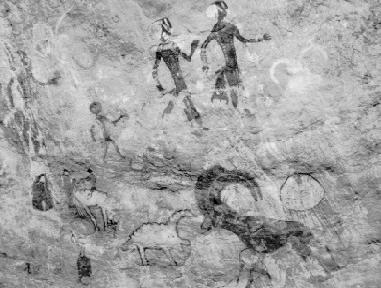
From a more recent time, the Mesolithic era, we find stone blades, tools, and small human figures from the Capsian culture. This culture is named after Gafsa in Tunisia. These finds are linked to the early presence of Berbers in North Africa. The Capsian culture was native to the Maghreb region from about 12,000 to 8,000 years ago. During this time, the last ice age ended, changing the climate in the Mediterranean. The African coast slowly became drier.
Some ancient monuments made of very large rocks, called dolmens, are also linked to the Berbers. These dolmens are found across the western Mediterranean, in both Europe and Africa. Before the Capsian culture, the Ibero-Maurusian culture existed in North Africa.
Saharan Rock Art
Saharan rock art includes drawings and paintings of animals, humans, and different patterns. These are thought to have been made by Berbers and also by black Africans from the south. It's hard to figure out exactly when these artworks were made. It's not likely that ancient Egypt influenced them much. Some pictures show a land that was much wetter than it is today.
The animals shown include large-horned buffalo (now extinct), elephants, donkeys, rams, herds of cattle, lions, leopards, hogs, rhinoceroses, giraffes, and hippos. Human hunters sometimes wear animal masks and carry weapons. Herders are shown with fancy head decorations. Some figures are dancing. Others drive chariots or ride camels.
How the Berbers Began
A common idea about Berber origins is that ancient peoples who lived in the region for a long time mixed with other groups. Two of these groups came from the east, near Southwest Asia, bringing the Berber languages about 8,000 to 10,000 years ago. One group traveled along the coast, and the other through the Sahara desert. A third group mixed in earlier from Iberia (modern Spain and Portugal). So, the people of the Maghreb are a mix of these groups: the Ibero-Maurusian, the Capsian, and the Neolithic people, who were the true early Berbers.
Scientists who study genetics also note that Berbers and people who speak Semitic languages (like Arabic or Hebrew) belong to a very old and large language family. This family dates back perhaps 10,000 years. This language family includes people from different genetic groups, including one from the Horn of Africa and the Sahel region. Recent studies agree that both Berber and Semitic populations share a common origin from the Neolithic period. Many believe that the Berbers are a mixed group of people who share related and ancient Berber languages.
About 8,000 years ago, there were already people living here. The early Berbers, coming from the east, mixed with them. From this mixing, the Berber people emerged. Today, half or more of modern Tunisians are likely descendants of these ancient Berber ancestors.
Berber Language History
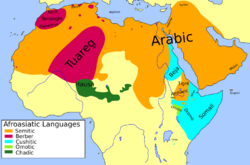
In the study of languages, clever methods help us understand how a language changes over time. We can try to reconstruct how people spoke in the past by looking at modern languages and how sounds and words change. We can also use old writings if they exist. Comparative linguistics helps us connect "sister" languages that came from an older parent language. These groups of languages can then form branches of even larger language families, like Afroasiatic.
The Afroasiatic Family
The many different Berber languages form one of the five main branches of Afroasiatic, a very important world language family. This family stretches from Mesopotamia and Arabia to the Nile river and the Horn of Africa, and across northern Africa to Lake Chad and the Atlas Mountains by the Atlantic Ocean.
The other four branches of Afroasiatic are:
- Ancient Egyptian
- Semitic (which includes languages like Akkadian, Aramaic, Hebrew, Arabic, and Amharic)
- Cushitic (found around the Horn of Africa and the lower Red Sea)
- Chadic (like Hausa)
The Afroasiatic language family has many different languages and a very long history. This is shown by both language studies and the age of its written records, which use some of the oldest writing systems. Scientists combine language studies with information from archaeology and biology to learn about prehistory. Earlier ideas suggested that the Afroasiatic homeland was in Southwest Asia, but more recent research points to Africa.
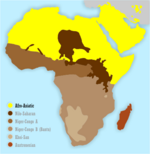
How Languages Spread
One idea is that the first Afroasiatic communities were near Darfur, a place that used to have more water. The "Egyptians" were the first to leave these communities, over 10,000 years ago, heading north. Over the next thousand years, the early Semitic and Berber speakers went their separate ways. The Semites crossed into Asia. Meanwhile, the people who spoke early Berbero-Libyan languages spread westward across North Africa. They traveled along the Mediterranean coast and into the Sahara (which was wetter then), in a migration that lasted centuries, until they reached the Atlantic Ocean and its islands.
The Early Berbers
Culture and Society
Around 7,000 years ago, a new culture was developing among the Berbers in northwest Africa. At an old cave called Haua Fteah in Cyrenaica, people who gathered food were replaced by people who raised animals and made pottery. Material culture improved, leading to animal domestication and agriculture. They also developed craft skills like making pottery with patterns and finely chipped stone tools.
The people who gathered food around the salt lakes of Tunisia were followed by simple farmers. These farmers didn't change their stone tool-making much. This period is called a 'Neolithic of Capsian tradition'. This means that the local food gatherers didn't get replaced by farmers from other places. Instead, they learned to farm themselves. In the Maghreb, this simple farming culture lasted for thousands of years.
Berbers grew wheat, barley, beans, and chickpeas. They used ceramic bowls, basins, goblets, and large plates for daily life. They might have worn hooded cloaks and cloth woven with different colored stripes. Sheep, goats, and cattle were a sign of wealth. From objects found in Tunisia, archaeologists believe that Berbers were already "farmers with a strong pastoral (animal-raising) side to their economy and fairly elaborate cemeteries" over a thousand years before the Phoenicians arrived to found Carthage.
Before written records, it seems that settled rural Berbers lived in mostly independent farming villages. These villages were made up of small family groups (clans) led by a local leader who tried to keep peace among them. Important decisions in these early Berber villages were probably made with a council of elders. Larger villages grew in very fertile areas. But sometimes, villagers might have moved to find better grazing land for their animals. In drier areas, more nomadic Berber tribes moved widely to find food for their animals.
It's thought that fighting between clans at first stopped these ancient Berber farmers from forming larger political groups. So, their social organization didn't go beyond the village level. Tribal authority was strongest among the wandering animal herders. It was much weaker among the farming villagers and became even weaker when cities with strong trade and foreign governments appeared.
Across the Maghreb (especially in Tunisia), the Berbers reacted to the growing military threat from colonies started by Phoenician traders. Eventually, Carthage and its sister city-states inspired Berber villages to unite and form large armies. This naturally led to strong, central leaders. The Berbers learned social and civic ideas from the nearby wealthy cities of Carthage and adapted them for their own use. To the east, the Berbero-Libyans had already interacted with the Egyptians for thousands of years.
The people we call Berbers today were often known as Libyans in ancient times. However, many "Berbers" have called themselves Imazighen or "free people" for a long time. A famous historian from the 1800s, Mommsen, noted that this name was used by different tribes and was even mentioned by the Greeks and Romans. This shows that this great people always felt connected to each other.
Mommsen also said that their ancient neighbors used other names for them: Libyans (by Egyptians and Greeks), Nomades (by Greeks), Numidians (by Romans), and later Berbers (by Arabs). In the west, they called themselves Mauri, and in the south, Gaetulians.
Some ancient Berber kingdoms might have names related to Imazighen. The Egyptians knew about a powerful Berber tribe called Meshwesh, whose leaders became pharaohs of the 22nd dynasty. Near Carthage, there was the Berber kingdom of Massyli, later called Numidia, ruled by Masinissa and his family.
Berbers, along with their relatives and descendants, have been the main population group in the Maghreb (North Africa, not including the Nile Valley) for about 8,000 years. This region stretches from the Nile river to the Atlantic Ocean, including the huge Sahara desert with its mountains like Ahaggar and Tibesti. In the west, the Mediterranean coastlands are good for farming, with the Atlas Mountains behind them. This area includes the land we now call Tunisia.
However, the oldest written records about the Berber peoples come from their neighbors in the Mediterranean region. When the Berbers first appear in history around 1000 BC, we unfortunately don't have their own stories or views on events. Because of the importance of Carthage, the people of Tunisia are the ones who appear most often in early historical writings about the Berbers.
Stories About the Berbers
Here we will describe the Berber peoples as they first appear in history, based on written records from Egyptians in Northeast Africa, and mainly from Greek and Roman writers in Northwest Africa. To the east of Tunisia, a Libyan family ruled Egypt. Their armies marched into Phoenicia a century before Carthage was founded. Next, we'll look at Berber life and society in Tunisia and to its west, both before and during the time Carthage was powerful.
Northeast Africa
Ancient Egyptian writings from early times mention Libyans, who were the Berbers living in Egypt's "western desert." They are first directly mentioned as the "Tehenou" during the reigns of early pharaohs like Scorpion II (around 3050 BC) and Narmer. The Berbero-Libyans are also shown in a carving at the temple of Sahure, from the Fifth Dynasty (2487-2348 BC). The Palermo Stone, also called the Libyan Stone, lists the earliest rulers of Egypt from the 31st to the 24th century BC. Some people think that the earliest rulers listed might have been Libyan Berbers, from whom the pharaohs came.
Much later, Ramses II (who ruled from 1279-1213 BC) was known to use Libyan soldiers in his army. Tombs from the 13th century BC show paintings of Libu leaders wearing fine robes, with ostrich feathers in their hair, short pointed beards, and tattoos.
Osorkon the Elder, a Berber leader from the Meshwesh tribe, seems to be the first Libyan pharaoh. Several decades later, his nephew Shoshenq I (who ruled from 945-924 BC) became Pharaoh of Egypt and started the Twenty-second Dynasty (945-715 BC). In 926 BC, Shoshenq (known as Shishak in the Bible) successfully attacked Jerusalem, which was then ruled by Rehoboam, Solomon's son. The Phoenicians, especially the people of Tyre (who would later found Carthage during Egypt's Meshwesh dynasty), first learned about the Berber people through these Libyan pharaohs.
For several centuries, Egypt was governed by a system that was somewhat based on the Libyan tribal organization of the Meshwesh. These Berbero-Libyans adopted Egyptian culture. Eventually, Libyans even served as high priests in important centers of Egyptian religion. Because of the fame of Egypt's Meshwesh dynasty, all the Berber peoples of North Africa were often called Libyans during the classical era.
Northwest Africa
West of Egypt's Meshwesh dynasty, later reports from foreigners mention more simple Berber people living by the Mediterranean Sea, in fertile coastal areas. Those in or near Tunisia were called Numidians. Farther to the west, the Berbers were called the Mauri or Maurisi (later the Moors). In more distant mountains and deserts to the southwest, Berbers were called Gaetulians. Another group of Berbers in the steppe and desert southeast of Carthage were known as the Garamantes.
During the 5th century BC, the Greek writer Herodotus (around 490-425 BC) mentions Berbers as soldiers hired by Carthage in Sicily, around 480 BC. After this, Berbers appear more often in the early history written by various Greek and Roman historians. Sadly, very little of Carthaginian literature has survived, except for some inscriptions. We do know that Mago of Carthage started hiring Berbers as soldiers in the 6th century BC.
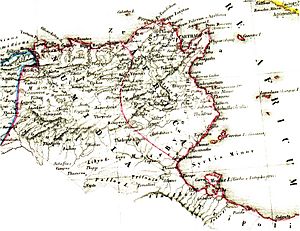
During these centuries, Berbers in the western regions actively traded and mixed with the Phoenicians, who founded Carthage and many trading posts. The name 'Libyphoenician' was used for the cultural and ethnic mix around Phoenician settlements, especially Carthage. The Berbers learned political skills and city arrangements from Carthage, as well as practical things like farming techniques, and adapted them for their own use. In the 4th century BC, Berber kingdoms are mentioned. For example, the ancient historian Diodorus Siculus mentions the Libyo-Berber king Aelymas, who lived south of Carthage and dealt with the invader Agathocles (361-289 BC), a Greek ruler from Sicily. These Berbers acted independently of Carthage.
Around 220 BC, three large kingdoms had grown among the Berbers. These Berbers were independent but greatly influenced by the civilization of Carthage. From west to east, the kingdoms were:
- Mauretania (in modern Morocco) under the Mauri king Baga.
- The Masaesyli (in northern Algeria) under their king Syphax, who ruled from two capitals: Siga in the west (near modern Oran) and Cirta in the east (modern Constantine).
- The Massyli (south of Cirta, directly west and south of Carthage) ruled by king Gala [Gaia], father of Masinissa.
After the Second Punic War, Massyli and eastern Masaesyli joined to form Numidia, located in historic Tunisia. Both Roman and Greek states honored its famous ruler, Masinissa, like a respected king.
Ancient Berber Religion
What we know about ancient Berber religion and sacred practices gives us some idea, though incomplete, of their inner lives. This also gives us clues about the character of the Berbers who lived when Carthage was founded.
Respect for the Dead
It's hard to fully understand the religion of the ancient Berbers. Burial sites give us early clues about their beliefs. More than 60,000 tombs are found in the Fezzan region alone. The way many tombs were built shows they were used for ceremonies and sacrifices. A grand tomb for a Berber king, often thought to be for Masinissa (238-149 BC) but possibly for his father Gala, still stands: the Medracen in eastern Algeria. The elegant tower tomb of his contemporary Syphax shows some Greek or Punic influence.
Much information about Berber beliefs comes from ancient writings. Herodotus (around 484-425 BC) mentions that Libyans of the Nasamone tribe would pray and then sleep on the graves of their ancestors. They hoped to have dreams that would help them predict the future. They chose ancestors who were known for being good and brave, believing their tombs had spiritual power. Oaths were also taken on the graves of good people. Because of this, the Numidian king Masinissa was widely worshipped after he died.
Reverence for Nature
Early Berber beliefs and practices are often described as a religion of nature. The power to create new life was symbolized by the bull, the lion, and the ram. Supernatural power could live in water, in trees, or in unusual stones (which Berbers would oil). This power might also be in the winds, like the strong Sirocco wind across North Africa. Herodotus wrote that the Libyans sacrificed to the sun and moon. The moon (Ayyur) was seen as male.
Later, many other supernatural beings were identified and became gods, perhaps influenced by Egyptian or Punic practices. However, the Berbers seemed more interested in the sacred power itself than in specific gods. Early worship sites might have been in caves, on mountains, in cracks in rocks, or along roads. The Berber writer Apuleius (born around 125 AD), writing about earlier times, said that altars were often simply made of turf, and clay vessels were used, with "the deity himself nowhere." Often, we only know the names of Berber deities, like Bonchar, a main god. Julian Baldick, who studied writings from many times and places, provides the names and roles of many Berber gods and spirits.
Mixing of Beliefs
The Berbero-Libyans adopted some ideas from ancient Egyptian religion. Herodotus wrote about a divine oracle, linked to the Egyptian god Ammon, located among the Libyans at the oasis of Siwa. This Libyan oasis of Ammon was like a sister oracle to one in Dodona, Greece, according to Herodotus. However, the god of the Siwa oracle might actually have been a Libyan deity. When Alexander the Great visited in 331 BC, the Siwa oracle became well-known throughout the ancient world.
Later, Berber beliefs influenced the Punic religion of Carthage, the city founded by Phoenicians. George Aaron Barton suggested that the important goddess of Carthage, Tanit, was originally a Berbero-Libyan deity. The newly arrived Phoenicians might have worshipped her to gain her favor. Later archaeological finds show a Tanit from Phoenicia. Based on language clues, Barton thought that before becoming a goddess of agriculture, Tanit probably started as a goddess of fertility, symbolized by a fruit-bearing tree. The Phoenician goddess Ashtart was replaced by Tanit in Carthage.
See also


